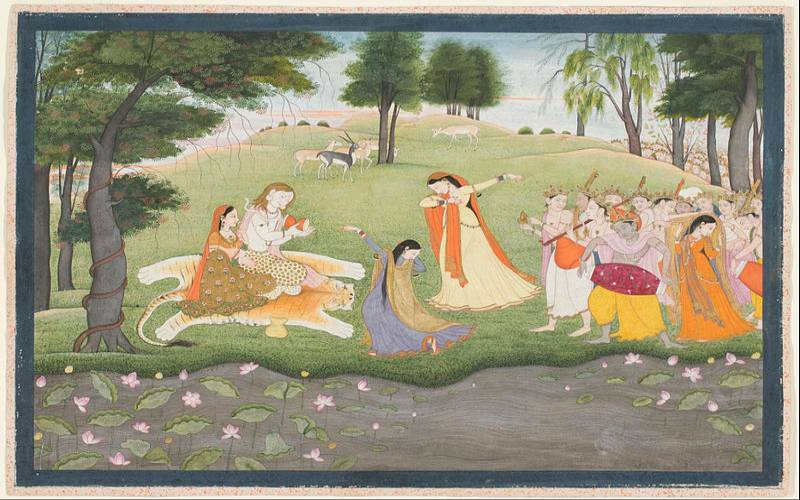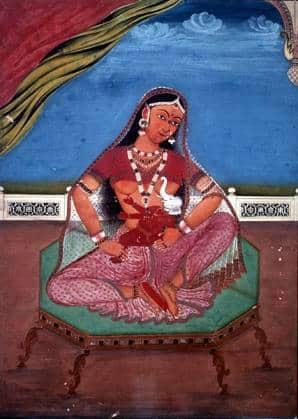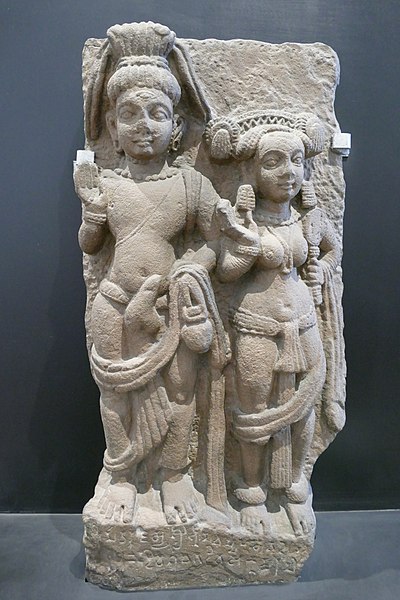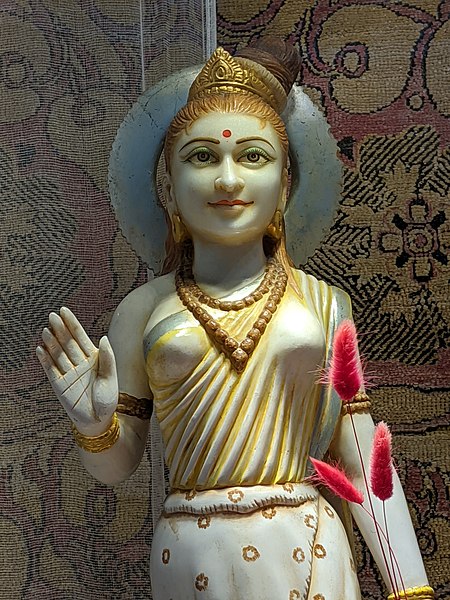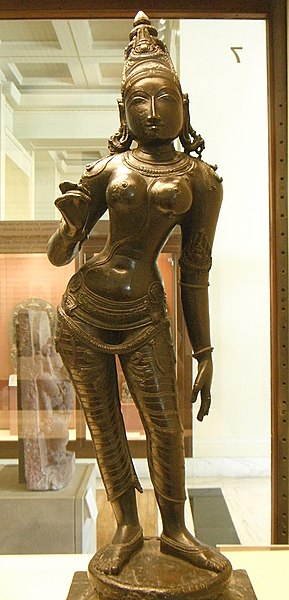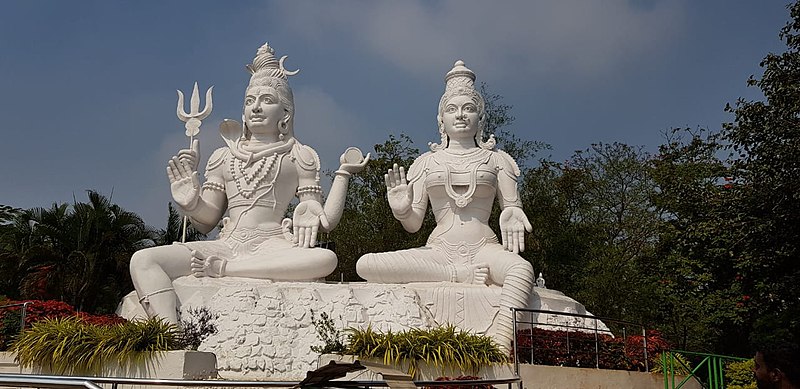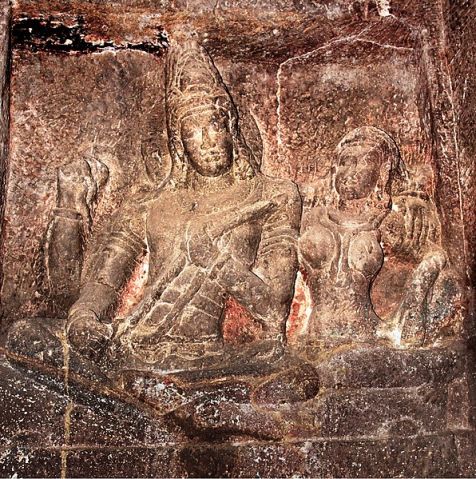In Hinduism, all creation is considered the union of Shiva and Shakti, representing the masculine and feminine aspects of consciousness respectively. Shiva and Shakti are symbolic of the divine energies inherent within all of us. The concept of Shiva and Shakti is like yin and yang and the balance between the two is essential for the smooth functioning of the cosmos.
Goddess Parvati is the manifestation of Shakti. She is the eternal spouse and lover of lord Shiva. Devi Parvati is the hindu Goddess of love, fertility, beauty, devotion, and motherhood. In the Hindu pantheon of Goddesses, every Goddess is the manifestation of Shakti. Devi Parvati is the nurturing and gentle aspect of Shakti.
She has many forms and aspects in Hindu mythology. Goddess Parvati is said to have over 108 names in regional Hindu mythologies of India. She constitutes the “Tridevi”, the trinity of Hindu Goddesses along with Devi Saraswati and Devi Lakshmi.
In the Vedic period, she was known as Ambika. She is also known as Uma, Durga, Kali, Gauri, Rajeshwari, Tripurasundari, Sati, etc.
Devi Parvati is the wife of lord Shiva. Therefore, Shiva and Parvati together symbolize supreme conjugal bliss. That is why married couples are advised to worship Shiva-Parvati to keep their marital lives smooth and trouble-free. Single women looking for suitable partners also worship lord Shiva and Devi Parvati together.
Goddess Parvati Symbolic Significance
Devi Parvati is the Hindu Goddess of divine power and strength. She is also described as the creative power and energy of lord Shiva. The union of Shiva and Parvati represents the procreative aspect of nature not just literally but also metaphorically. The union of lord Shiva and Devi Parvati also symbolizes the regeneration of creative energies.

The name “Parvati” is derived from the Sanskrit word Parvata meaning a mountain. Thus, Parvati literally means “the daughter of the mountains”.
In Hinduism,Devi Parvati symbolizes regenerative power. She is the manifestation of the divine feminine energy Shakti. Parvati is the voice of reason, strength, resistance, and action. She is a devoted wife, a nurturing mother, and benevolent to all her devotees.
Although worshipped primarily as a Goddess of marriage and fertility, Devi Parvati also symbolizes asceticism as she went through a deep meditative state in the forest to win the love and affection of lord Shiva. Thus, she is an equivalent to lord Shiva when it comes to the power of detachment and asceticism.
Devi Parvati Origins: Daughter of the Mountains
Parvati is the daughter of King Himavan (the mountain king) and Queen Mena. Goddess Ganga is considered her elder sister.
In her previous incarnation, she was born as Sati. She was the daughter of Daksha (Prajapati), the son of Lord Brahma. She adored Shiva and wished to marry him. But as Lord Shiva was an ascetic, her father didn’t agree to this union. But she was adamant and married him. She started living on Mount Kailash with Lord Shiva. After a few years, her father planned a massive yajna to which all Gods and Goddesses were invited except Sati and Lord Shiva. She wanted to go to this event. Despite Shiva’s best efforts to persuade her against going, she went to see her parents.
But on arriving there, she was given the cold shoulder. She was humiliated for his choice in marriage and living conditions. After some time, she couldn’t take it any more and jumped into the raging flames. Shiva was furious upon hearing the news of her self-immolation. He dragged his wife’s half-burning body from the flames. As he was going over various mountains, Sati’s body parts dropped in various locations. It is believed that Sati’s body parts were dropped at 52 different places, known as Shakti Peethas.
The Immortal demon Tarakasura
After Sati’s death, Lord Shiva was devastated. He went to the Himalayas and completely secluded himself. He went into deep meditation. In the meantime, the demon Tarakasura won a boon from Lord Brahma that he should die only at the hands of the son of Lord Shiva and his wife. He thought that, as Sati was dead and Lord Shiva was alone in the forest, there would be no children. Therefore, he would be immortal.
But concerned Gods went to King Himavan and requested that he have Sati as his daughter. Himavan agreed, and Sati was reborn as Parvati. But according to Narad Muni’s oracle, she could marry Lord Shiva only after a severe penance. So she practiced austerity to please Lord Shiva, and finally their union was blessed.
Representation
Parvati is generally depicted as a gentle mother. She is also shown in her fierce forms, such as Durga and Kali. But she is always shown to be calm. Parvati is depicted as beautiful, fair and benevolent. She is often portrayed as having a golden complexion, which symbolizes her as the Goddess of harvest and fertility.
Devi Parvati is often depicted wearing a red sari along with a headband. She is shown with two arms when she appears alongside Lord Shiva. Alone, she is shown with four arms. Her hands are sometimes depicted holding a crown, conch, mirror, bell, rosary. Dish, farming tools such as goad, flowers such as lotus, sugarcane stalk, etc.
One of her children, Ganesha, is often seated on her lap. Her second child, Skanda or Kartikeya, may be seen playing near her.
Her one hand displays the Abhaya mudra (gesture for fear not). It may also be shown in kataka (a gesture for fascination and enchantment). Her left hand sometimes shows Tarjani mudra (a gesture of menace).
Sometimes, a parrot can be seen near her shoulder, symbolizing cheerful and loving talk. Also, a crescent moon is shown on her head, which symbolizes her being half Shiva. Parvati is frequently depicted as the ideal housewife who cares for her family and society.
In ancient Hindu temples, Devi Parvati’s sculpture is often depicted near a cow or a calf -a source of food. Most ancient temples have her sculptures carved in bronze or stone.
Legends of Goddess Parvati
There are many legends associated with Goddess Parvati. Because she appears in so many forms, each one has its own legend. For example, as Durga, she kills the demon Mahishasura. As Kali, she kills the demon Shumbha. As Annapurna, she provides food to all.
According to a legend, one day, Parvati came from behind Lord Shiva. She closed his eyes, and the whole universe missed a heartbeat. There was a loss of life and light. To correct this, Lord Shiva asked Parvati to practice severe penance. She went to Kanchipuram (Tamil Nadu). When she was worshiping the linga (a symbol of Shiva) there, Shiva created a flood. But she stayed there and saved lives from being destroyed. This place is also considered to be the place where Lord Shiva married Parvati.
In Tantric traditions, there is a story of how Parvati gave birth to ten Mahavidyas (wisdom Goddesses). As the story goes, once Shiva and Parvati were living with her parents. After some argument, Shiva attempts to walk out. But an enraged Parvati manifests as these Goddesses, blocking every exit.
Parvati and Lord Shiva: Eternal Love
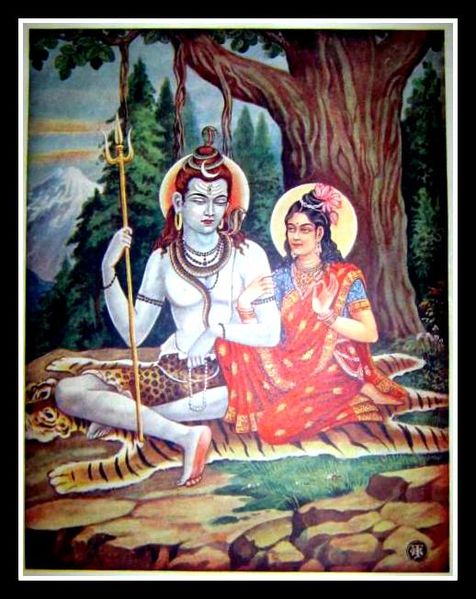
According to stories, Parvati adored Lord Shiva and resolved to marry him. But her parents were against the union. They imagined Lord Shiva as an ascetic, not a householder. But Parvati didn’t lose hope. She began living in the forest , performed penance to show her resolve and also to draw the attention of Shiva.
He meets her in various disguises to dissuade her from pursuing Shiva. But she was adamant. Finally, Shiva agreed and married her. He loved her deeply and also dedicated hymns to honor her.
They are often shown joined together. Together, they are known as Ardhnarishwar (half man, half woman). A popular legend associated with this form holds that lord Brahma first created male beings. He instructed them to create other beings, but they were unable to do so. To make Lord Brahma realize his mistake, Lord Shiva appeared before him in this androgynous form. Lord Brahma realized his omission and created females.
She is considered to be the energy and power of Shiva. Both are often symbolized by a yoni (womb) and a linga. This represents the union of the feminine and the masculine, and hence the eternal process of creation and regeneration. They jointly symbolize the power and blessing of marital felicity.
Shiva and Parvati’s Children Kartikeya and Ganesha
Parvati is the mother of Hindu deities Ganesha and Kartikeya. There are numerous stories related to both of them.
Kartikeya is the elder son of Goddess Parvati and Lord Shiva. His birth story has different versions. According to one myth, Parvati didn’t give birth to Kartikeya. It is said that the Goddess was cursed so that she would never be able to bear children.
But according to the oracle, they were to have a child who would kill the demon Tarakasura. So they went to a cave and meditated. Because of their devotion, a ball of fire emerged out of the cosmic energies. It was so powerful that even Agni (the goddess of fire) was not able to hold it. As a result, they presented the ball to Goddess Ganga. But even Goddess Ganga couldn’t take it much longer.
Finally, Parvati took the form of a water body. The ball took the form of a baby with six faces. Kartikeya was born. Kartikeye killed Tarakasura and became the commander-in-chief of the Gods.
The Birth of Ganesha
The birth of Ganesha is also associated with a legend. According to this, Parvati once wanted to take a bath, but there were no attendants available. So there was no one to guard her or stop anyone from entering accidentally. So, she created an image of a boy out of turmeric paste and infused life into it. And that’s how Ganesha was born.
Parvati told Ganesha not to allow anyone to enter the house while she was bathing. After a while, Shiva came back with other Gods. But as an obedient son, Ganesha didn’t allow them to enter. Shiva was furious, and he severed the boy’s head. When Parvati saw the headless body of her son, she was devastated. She demanded to give back her son. Shiva gave him life by attaching an elephant’s head to his body.
Manifestations
Mahadevi is considered to be the supreme goddess in Hinduism. And Parvati is considered a physical representation of Mahadevi in her complete form. All Goddesses are said to be the manifestations of this single great supreme deity. Her manifestations and incarnations are said to depend on her mood. She is considered Shakti, and hence, pure energy.
Her most popular incarnation is her previous birth as Sati. Sati’s body parts are said to have been dropped at 52 different locations across India. These are called Shakti Peethas. These Shakti Peethas are considered different aspects of the goddess Parvati.
As Durga, she kills demons. She killed Mahishasura, Shumbha, and Nishumbha. The nine forms of Durga are said to depict a point in the life of Parvati. She becomes Kali at the request of Lord Shiva. She destroyed asura Daruk. But even after killing the demon, she couldn’t control her anger. To calm her, Lord Shiva appeared as a crying baby to arouse her maternal instincts. On hearing the baby’s cries, she turned back to being Parvati.
Meenakshi is another of her names. In this form, she has eyes shaped like a fish. She is said to be the daughter of a devout, childless queen. She was born with three breasts. Eventually she met Lord Shiva and returned to Mount Kailash as Parvati.
In the form of Nanda Devi
As Nanda Devi, she is the Goddess of bliss and resides in the hill state of Utarakhand. Goddess Parvati is also known as Shailputri in the Garhwal and Kumaon regions of north India. As Sheetla Mata, she was incarnated to save the world from diseases. As Annapurna, she represents abundance. Parvati assumed this form to teach the inhabitants of Mount Kailash the value of food. In Buddhism, goddess Tara is said to be related to Devi Parvati.
Also, there are many local manifestations of Goddess Parvati, revered to protect the area from epidemics and local diseases.
Devotion
Devi Parvati is known by her devotees as Kamarupa, one who shapes and fulfills all the desires. She is said to inspire her worshipers to embrace their strengths and flaws. And she also helps to utilize these qualities to achieve their potential in life.
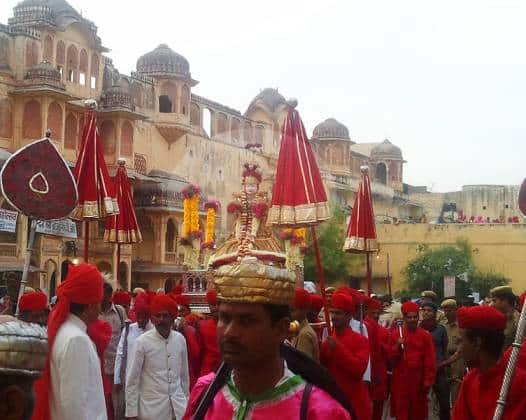
The three-day festival of Teej is celebrated to honor her. It is celebrated at the onset of the monsoon. Hindu women wear yellow clothes and sing folk songs. Unmarried girls pray to Parvati for a good husband, and married women pray for the good health of their husbands. Her worship is done to have a good marriage, resolve conflicts between couples, and help with fertility.
Also, the festival of Navratri is celebrated to honor her manifestations.
Goddess Parvati Festivals
Gowri Habba Festival
Also known as Gauri Festival, it’s celebrated in the Indian state of Karnataka to worship Devi Parvati. Celebrated on the seventh, eighth, and ninth of Bhadrapada(Shukla Paksha), this festival is celebrated mainly by women who worship Devi Parvati as the Goddess of harvest and protector of women. It’s also closely linked to Ganesh Chaturthi, a festival celebrated in veneration of lord Ganesha who is Devi Parvati’s son. Besides Karnataka, Gowri Habba festival is also popular in Maharashtra.
Gangaur festival
Devi Gauri or Parvati is also worshipped during the Gangaur festival in the Indian state of Rajasthan. This festival usually starts from the day after Holi, an important Hindu festival falling in the month of March. It’s a long festival that goes on for 18 days. During this time, images of Goddess Parvati are carved out from clay and worshipped by devotees.
Gauri Tritiya
A popular festival in Maharashtra celebrated mostly by married women. Legend has it that Devi Parvati spent a month at her parents’ home during the time of this festival. During this festival, women and girls are invited to households and gifted coconuts, fruits and flowers, packets of saffron and turmeric, and various other small gifts. The women of the household create a series of platforms in the shape of a pyramid with the image of Devi Parvati at the top along with a collection of images of other Hindu deities, shells, pictures, ornaments, etc below. Prayers are held at night time along with dancing and singing rituals.
Teej
Teej is the most popular festival for Hindu women, especially in north India and western India. It is essentially a celebration of marital bliss. Parvati is the main Goddess worshipped during this festival. Teej falls during the period of monsoon in India, therefore it’s also celebration of monsoon. Teej is the most widely discussed festival in literature with so many songs and poems and literary text dedicated to the occasion. The most common visual images of Teej are women enjoying the ride of a swing while lovingly remembering their husbands and lovers. Teej is essentially a festival of marital love – it signifies the love and devotion of a married woman for her husband and how she pines for him when he is not near her.
Teej is also celebrated by unmarried women for whom it is essentially a festival devoted to praying for getting a good husband. In north India, during this festival, women and girls dress up in traditional Indian wear, decorate themselves with ornaments and also apply henna or mehndi on their palms.
Goddess Parvati Temples
India has many famous temples dedicated to Devi Parvati. These temples have a string of legendary stories and myths attached to them. The style of architecture and sculptures vary depending on the location of the temple.
Some of the famous Devi Parvati temples in India are:
- The Parvati Temple in Khajuraho, Madhya Pradesh
- Garija Devi Temple, Uttarakhand
- Ambaji Temple at Ambaji Gujarat
- Tiruvairanikulam Sri Parvati Temple, Aluva
- Meenakshi Temple, Madurai
- Visalakshi Temple at Varanasi, Uttar Pradesh
- Kamakshi Amman Temple at Kanchipuram
- Attukal Temple in Thiruvananthpuram Kerala
Goddess Parvati Symbols
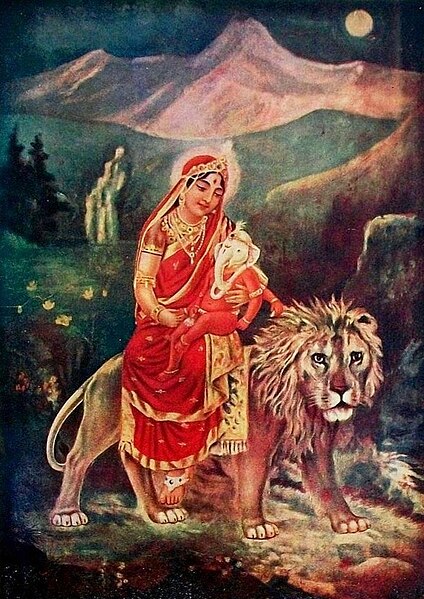
Colors
The colors associated with Devi Parvati are the same as those associated with Durga.
- White – Symbolizes peace and serenity
- Red – Symbolizes love and is considered Goddess Durga’s favorite color.
- Blue – Symbolizes richness.
- Yellow – Symbolizes happiness.
- Green – Symbolizes growth and nature.
- Grey – Symbolizes balanced emotions.
- Orange – Symbolizes warmth and positivity.
- Peacock green – Symbolizes uniqueness
- Pink – Symbolizes kindness.
Plants
Flowers like champa, mogra, and palash are frequently associated with Goddess Parvati. She also favors red flowers, lotus, and hibiscus. But she is said to like all the flowers offered to Lord Shiva.
Animals
Tiger: Tiger symbolizes unlimited power and the strength to use it to protect virtue.
Lion: The lion symbolizes uncontrolled animalistic tendencies such as anger and greed. Her sitting on the lion reminds us to control these qualities.
Elephants: Elephants are considered close to Parvati, as her son, Lord Ganesha, has an elephant’s head.
Perfumes/Scents
Goddess Parvati is often associated with scents of vanilla, amber, and sandalwood. These fragrances show her as a goddess of perseverance. These also symbolize her name as “daughter of mountains.”
Gems and Metals
In her form as Durga, Parvati is often associated with Pearls, White, Yellow and Blue Sapphires, Emeralds and Ruby.
Planet
The moon symbolizes Parvati. The moon represents Devi Parvati as a Goddess of wisdom.
FAQs about Parvati
Parvati is the goddess of love, devotion, and nourishment. She is considered a goddess of universal power, freedom, strength, and justice.
Goddess Parvati can be pleased by chanting mantras and worshiping her. She should be offered flowers, and women at festivals often offer her red bangles.
After her self-immolation, Sati reincarnated as the daughter of the Himalayas, known by the name of Parvati.
Lord Shiva and Goddess Parvati’s children are Lord Kartikesh and Lord Ganesha.
- Siva-Parvati in the Indian Museum, Kolkata – scultpure of red sandstone, ca 5th century C.E., Kausambi, Uttar Pradesh
- this is a depiction of Parvati, the female counterpart of Shiva.
- The consort of Shiva is shown in this bronze sculpture as a beautiful young woman. Her pose is the classic tribhanga, in which the body is bent in three directions – from the legs; the trunk and neck.
- Shiva-Parvati statue in Kailasagiri in Visakhapatnam, Andhra Pradesh
- Siva playing a stick-zither vina for Parvati in Ellora Caves, image in side passage of Kailash temple (cave 16)
Other Goddesses
If you enjoyed this post we are sure you will enjoy getting to know some of the other goddesses we also write about. You can find the complete list of goddesses sorted across regions and religions here.
Featured Image Credit: Philadelphia Museum of Art, Public domain, via Wikimedia Commons

